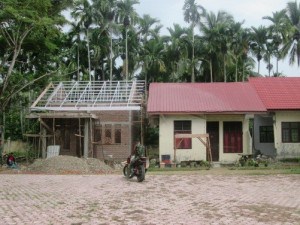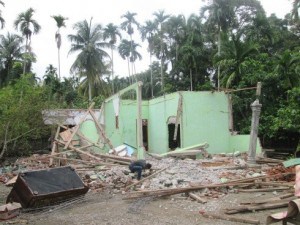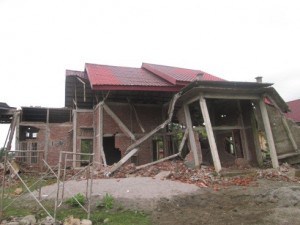Today we visited two more affected sub-districts in Pidie Jaya. In the morning we went to Bandar Baru sub-district and visited two schools. The buildings are confined masonry, and include teacher housing. Walls have collapsed in a few of the classrooms and the library building.
The damage that we found in those two schools are quite similar to the damage at the schools we visited earlier in the week: cracks in the walls near windows and doors, and separation between columns, beams, and walls.
One of the buildings with teacher housing has metal roof framing and metal sheet roof covers.
We then went to Jie-jiem village, one of the most affected areas in Bandar Baru sub-district. According to the village leader, there are 77 damaged houses- about 60% houses in the village. The majority are confined masonry houses, and none are more than one story. 35% are timber framed houses, or are combined with a confined masonry portion.
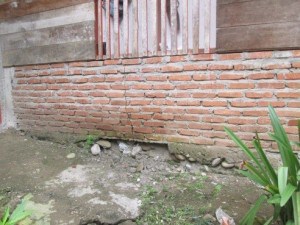
Building materials are not easily accessible- many people prefer to get their bricks from the Bireuen area (6 hours away). The village leader and some homeowners whom we interviewed are very interested in good construction practices. We gave them some of our bluebooks to help support their reconstruction efforts.
We also visited two villages, one in the Meredeu sub-district, and another in the Trienggadeng sub-district. There are still a lot of people stays in the tent or camp in both villages. The one in Meredeu is much denser than the one in Trienggadeng. About 50% of the houses in Meredeu were timber framed, while in Trienggadeng nearly 70% were confined masonry.
The damage to the confined masonry houses, however, was more obvious in Trienggadeng. We only have a general overview of these two villages, as we did not assess any individual houses.

Brickmaking Kiln in Mee Pawang
We met one brickmaker in Mee Pawang village, in the Trienggadeng sub-district, and visited his kiln. The kiln is badly damaged due to the earthquake. It is similar to the ones used in Lhokseumawe, but the wall is lower (around 1.5 meters tall) and thicker at the bottom. From what we observed the clay that he uses is quite good, which he bought from a producer at Rawasari Hill, just a few kilometers from his kiln. He used a machine for mixing the clay, and the mixture looks fine, although we still found some bricks that were not mixed well. The size is much smaller than the ones in Padang, similar to the ones in Lhokseumawe but a bit thinner (3.5 x 10 x 16 cm). We brought one of his bricks to be tested in our office in Padang.
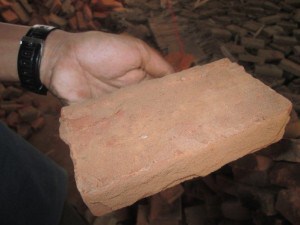
Brick from Mee Pawang village
There are around 5 kilns in this village. According to the brickmaker we interviewed, however, there are around 40 kilns in neighboring Kuta Pangwa village, where we visited the day before.
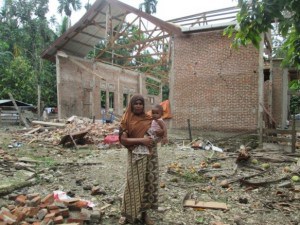
Erlilawati near her damaged home
We spoke with Erlilawati, one of the homeowners in Jie-jiem village. When the earthquake happened in the early morning, her husband woke up and quickly brought 4 of their children out of the house while she covered her twin babies while the walls began to collapse around her. The wall collapsed on her, and she suffered a spinal cord injury as a result. Her husband came back into the house to help them escape, but unfortunately more of the house collapsed with him inside. Luckily, some neighbors quickly got them out of the house after the earthquake stopped.



